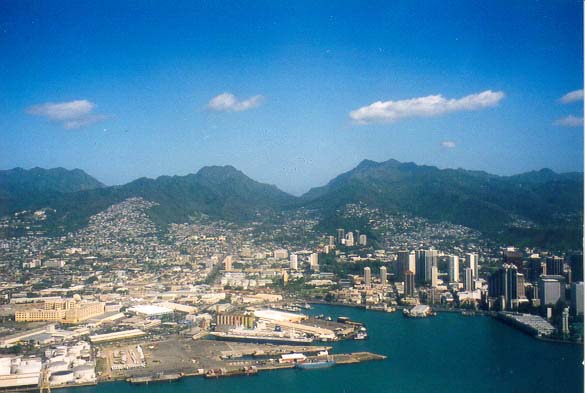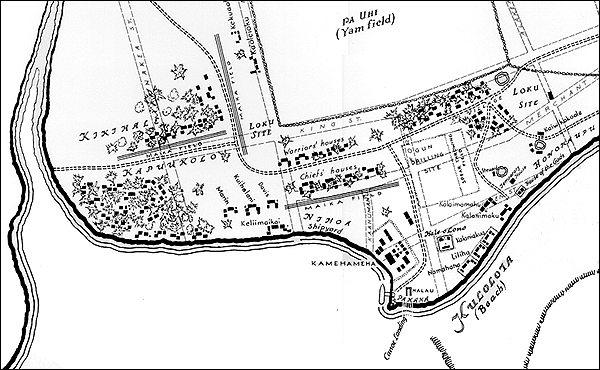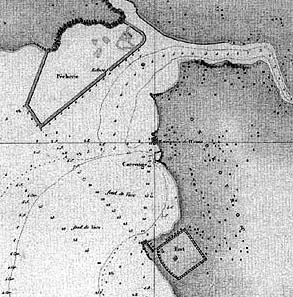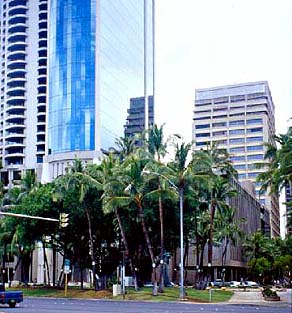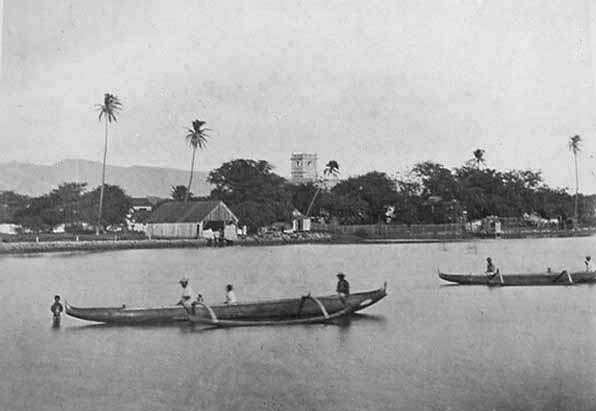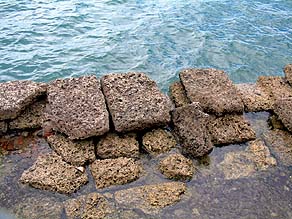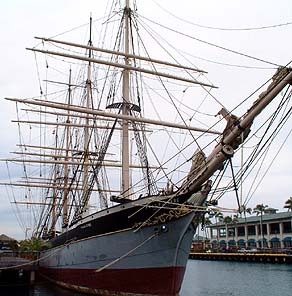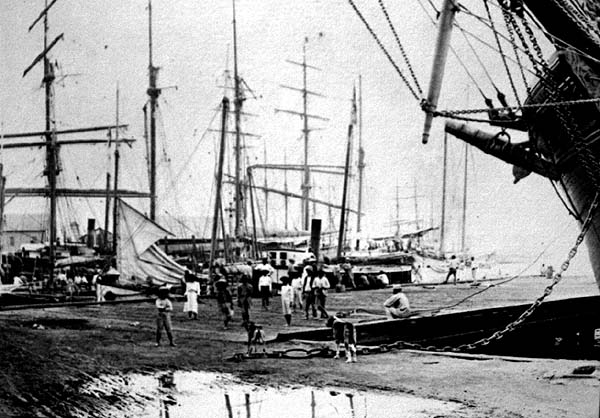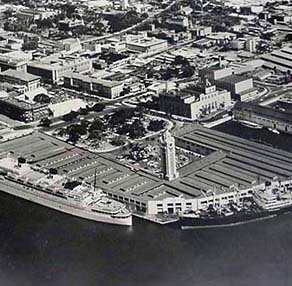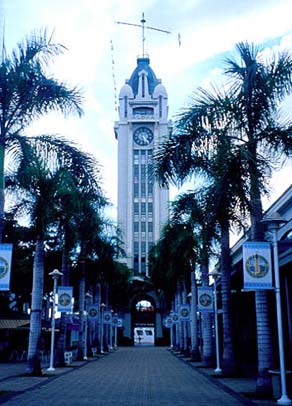 |
 |
 |
|||||||||||||||||||||
|
|
|
|
|
|
|
|
|
||||||||||||||||
|
|
|||||||||||||||||||||||
|
|
|
|
|
|
When Hi‘iaka and Wahine-oma‘o were returning from Kaua‘i to Hawai‘i Island with Lohi‘au, in the story of Hi‘iakaikapoliopele, it is stated that they arrived at the harbor of Kou, now the port of Honolulu. Emerson (1997) wrote, "At the entrance to this land-locked harbor of Kou a pretty sight met their eyes: a moving picture of men and women in the various attitudes of lying, kneeling or standing on boards, riding the waves that chased each other toward the sandy beach. The scene made such an appeal to Hi‘iaka's imagination that she opened her heart in song":
|
|
|
"Under her piloting, accordingly," Emerson continues, "they made their way by paddle across the beautiful land-locked harbor of Kou and, entering Nu‘uanu stream -- in those days much broader, sweeter and deeper than now -- turned into its eastern branch and erelong found themselves at the landing from which a path led up to Pele-ula's residence." This mention of Pele-ula invokes the seaside village of Kou before it became Honolulu Harbor. Honolulu means 'sheltered harbor' and it was this safe anchorage inside the reef that transformed the ‘Ili of Kou into the City of Honolulu. Hawaiian canoes were shallow-draft and could skim over the reef to beach anywhere. But when deeper-draft Western ships arrived, the Port of Honolulu emerged quickly as a prime anchorage, and a great deal of trade and interaction between the Hawaiians and Western visitors took place here.
|
||
|
|
||
|
|
"Before Kamehameha, this area had all the elements of life in abundance," Jim Bartels explains. "This area was extensively settled and cultivated before Kamehameha. The old harbor chants and stories involving Honolulu harbor reach all the way to Pearl Harbor. Chiefs didn’t live here; they lived in Waikiki. "There were about six or eight fishponds down at the harbor, and one or more of them would have been for the royalty. And there were fishponds going almost to the edge of Waikiki, here and there along the shore, and then in this harbor, and going all the way down to Pearl Harbor. Some of those existed until the 1930s or 1940s. "But traditionally it was a rich, wealthy area, well settled with people who had all that they needed to live comfortably."
|
|
|
|
“Kamehameha settled here. He loved the Big Island, and would have loved to have lived there, and he returned there in 1812. But this is where the foreigners were, because of Honolulu Harbor. If you wanted to keep an eye on these hardworking, mysterious, very dangerous visitors to the islands, you would have to be here. "And so Kamehameha established his court here, staying here until he was aged enough to realize that he didn’t have much longer to live. Then he went back to the home of his dreams (on the island of Hawai‘i) and five years later, he died.”
|
|
|
|
|
In 1817-18, ships arrived in Honolulu at the rate of 4 per month. Charles Sturgell (1983) writes that most of these were American ships engaged in the Sandalwood Trade. As sandalwood declined, whaling began off Japan, and American whale ships began flooding the Hawaiian Islands since Japan was closed to foreigners. During the "golden era" of whaling, 1843-1860, there were often hundreds of ships at a time calling on Honolulu. This heavy pressure on the limited facilities prompted the Kingdom to undertake expansions and improvements of the harbor area. The old Fort was dismantled and modification and expansion of the shoreline began.
|
||
| |
||
|
"That whole shoreline is totally artificial," John Clark tells us. "There’s nothing left of the original shoreline in that ahupua‘a. It’s all man-made, it’s all developed. "The old fort from Fort Street, the foundation now is all filled in. It was uncovered a few years back when they built a new high-rise right there. Apparently some of the building blocks of the fort are now at the foot of the street, in the water there. You can still walk over there and see them. I believe that’s the only visible remnants of anything historic on that shore right now." Click here to see a map of Honolulu in 1843.
|
|
|
|
As the port development continued into the 20th century, much of the cargo activity moved to the newly created Sand Island, discussed in the Reef page. A fishing fleet of sampans resided in the harbor as well, but perhaps the most spectacular activity was the arrival and departure of passenger ships. Mel recalls: “I used to live in Kalihi, and would walk to town. It was the old fisherman days: the harbor was smaller and the old sampans were there. I used to frequent the waterfront, especially down the dry docks all the time. I used to watch the divers—they used to go free diving to set the keels underneath the ship, so that it would balance. "See, when a ship comes in, the dry-dock is full with water, and the divers go down and set these heavy wood braces underneath the ship—sort of like wedges—on both sides. Then they drain the water, and the docks come up, and the ship is wedged in. Then the workers would go to work. But I used to like watching the divers go down."
|
|
|
|
|
|
“Pier Two was where all the action was, across the street from Honolulu Iron Works. They used to do all the repairs for the inter-island steam ships: Hawaii, Humuula, Hualalai, Waialeale, all those ships. Constantly they had plenty of work over there. “My oldest brother was always down at the pier on ship day. They used to call them the ‘wharf rats.’ They’d dive off the pier, or dive off the ships, and they used to dive from pretty high places. Tourists on the boat would flip coins over, and the divers would go down. Sometimes there were plenty of divers in the water already, combing for coins. Sometimes they did special dives, sometimes from the boat. I think some of the divers used to get paid before they dove. "Then they were sticking around, my older brother and them, which meant that, we were all going to share the rewards if he makes money. But that diving was something to behold at that time."
|
||
| |
||
|
“The big cruise ships from the mainland would come maybe twice a month, I think. That was a big day. Especially for lei sellers and taxi drivers. And of course in the town, for the food places. It was a way of life. That was Hawai‘i back then. “I lived with my grandfather, and I remember going to Hawai‘i (island) with him. Going to the island with him was a big deal, you know. There were all the families over there with leis and streamers. It was a time when everybody had a lot of aloha for each other, especially when you’re leaving. And when you’re coming home, it’s a big deal. “When my mother and my dad went to the other islands, they traveled with big suitcases, like they were going to Europe! It was big, all that extra clothes you had to put on. And the hats, because men and women, if you got dressed and you didn’t have a hat on, you weren’t dressed!”
|
|
|
|
“It was that way even when I was little," says Mel's wife Carol. "Everyone had their favorite lei seller. You would never change lei sellers and go to someone else. To go say aloha, everyone dressed in those days. The men in suits or sport jackets, women in dresses, high heels and stockings. Yet everyone looked cool and tropical. "The state room parties were wonderful! Champagne and dozens of hors d'oeuvre, what we call "pupu". The scent of flowers, particularly ginger and plumeria lei, filled the corridors. It was heartbreaking when the steward walked through ringing the chimes and you knew you had to say aloha. "On Boat Day, you would run into everyone! Family, friends, everybody would be down there because the ship was leaving. And you could see the ship pulling out from up where Liberty House is, because there were no high buildings, you could see down there, you could see the crowds. "And the streamers from the ship to the dock would be so thick you couldn’t see the ship. Then the band would strike up Aloha ‘Oe and everybody would just cry, whether you were on the ship or on the dock, you were crying.”
|
|
|
|
|
“Today it’s different, it’s a bigger scale today," Mel reflects. "But you look back to those simple days, I kind of miss it. It becomes memories, good memories, but at the same time today, when you understand where we are today and why so much history was not revealed, it’s kind of sad. Hawai‘i was a place of aloha." With the waterfront so developed today, many of the beaches are found in a new location.
|
||
|
|
||
| |
| |
|
|

|
| Nu‘uanu Home | Map Library | Site Map | Hawaiian Islands Home | Pacific Worlds Home |
|
|
|||
| Copyright 2003 Pacific Worlds & Associates • Usage Policy • Webmaster |
|||
